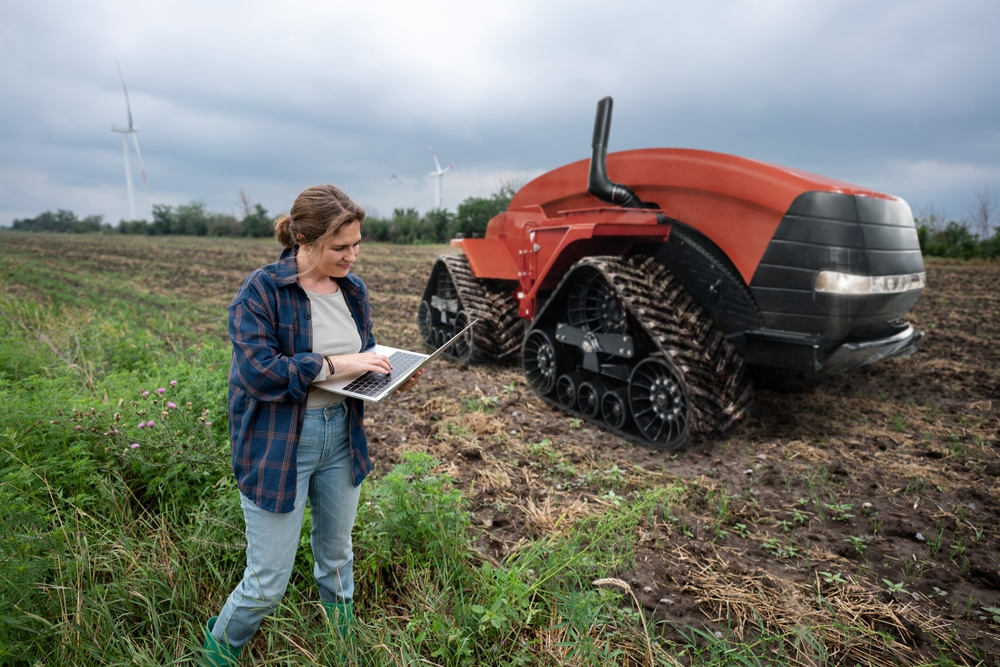With connected tech used at every level on farms and production sites, our food is vulnerable to cyberattacks.

Advances in agriculture technology have allowed farmers to do incredible things in recent years. Beyond just improving crop yields and reducing input costs, farms can monitor their fields from across the world. They can use drones to get aerial views without trekking through acres and acres. They can keep track of how each cow in their herd is moving, eating and even how much they’re chewing. But an increased reliance on technology could put our farmers at risk. The more tech used, the more opportunities for cyberattacks that could jeopardize the food supply chain.
Automated feeding and watering systems, autonomous soil treatment systems or even smart heat pumps or air conditioners all have the capability of connecting to the internet—they’re known in security circles as “endpoints.” For each of these endpoints on the farm, there is a vulnerability that can be exploited by malicious actors.
To proactively address these risks, it’s critical that software manufacturers in this sector prioritize security in their products and components. Security must be planted into every stage of this supply chain, from the farm to the supermarket, to ensure entire systems remain protected against any potential cyberattacks. These aren’t simply empty threats. Hackers are jail-breaking tractors and they’re using ransomware to go after individual farms. Earlier this month, a Quebec agricultural group, l’Union des producteurs agricoles, dealt with a ransomware attack that impacted its more than 40,000 members.
It can be difficult to stay on top of all the risks because of the complexity of the tech and the truly diverse applications of it all. From connected and increasingly autonomous farming equipment to large-scale refrigeration units, manufacturing plants with complex operations and technology and huge transport fleets, each link of the chain presents a potential security threat. Among other best practices, it’s essential that all endpoints are protected with the latest embedded security protocols and that all devices are regularly updated with the latest security patches.
Interestingly, humans have been proven the weakest links in the cybersecurity chain. If organizations adopt “cyber hygiene,” such as using two-factor authentication and making all passwords “long and strong” (and private), this will help guard against some of the most common pitfalls that allow malicious actors in. Unlike farmers, cybercriminals can be quite lazy, so a small amount of protection can cause them to take their malicious activities elsewhere.
To ensure that the food supply chain remains reliable and resilient for all, it’s essential that stakeholders work together to share information and best practices around appropriate cybersecurity standards—this includes software manufacturers, farmers, food processors, retailers and regulators. Education is the best tool for defence across the industry, and ensuring a free flow of information is one way to best protect the food supply chain from start to finish.
Given the costly and devastating consequences that a successful cyberattack could have on the food supply chain, it’s crucial that the agricultural industry takes a proactive approach to cybersecurity, focusing on embedding protection rather than simply reacting to threats after they wreak havoc. As the global population continues to grow, the demand for food increases, making this industry a key target for cybercriminals and bad actors who have the potential to cause widespread disruption on the world stage. The successful integration of technology in agriculture ultimately depends on how well they can invest in robust security measures, conduct regular risk assessment, and ensure all stakeholders are aware of the latest security threats.
It is vital that we apply all the cybersecurity knowledge we have to protect our essential agricultural resources. If you are not a cyberexpert, reach out to the professionals who live and breathe this space every day. An ounce of prevention is worth a pound of cure, and one cyberbreach will be much more costly than taking a proactive approach.
Charles Eagan is chief technology officer at BlackBerry. A dynamic leader and IoT expert, Eagan has been at the forefront of new frontiers in digital connectivity for more than 30 years. Eagan’s career has included many industry firsts, with a strong focus on security and innovation in every role. At BlackBerry, Eagan is responsible for the advancement of new technologies, driving innovation within emerging markets and advancing security capabilities that leverage Artificial Intelligence and Machine Learning. He is also responsible for technology research with an emphasis on driving automotive cybersecurity.
“Unlike farmers, cybercriminals can be quite lazy, so a small amount of protection can cause them to take their malicious activities elsewhere” That’s a rather worrying statement by someone of that background to make! Some cyber criminals may be quite lazy, but only because they generally use automation to attack and subdue a target. A small amount of protection can be useful, but only if it’s kept updated regularly: one of the worst practices by industries that tend to buy black-box IT solutions is to not update their systems, and it’s then that the cyber criminals take control. If the… Read more »
Cybercriminals, unlike farmers, can be quite sluggish, so even a little bit of security can deter them from committing cybercrime in one place and moving on to another. That’s a shocking claim for someone from that background to make! It’s true that some cybercriminals take the easy way out, but that’s usually because they rely on automated tools to launch attacks and gain control over their victims.